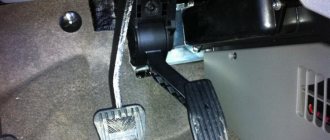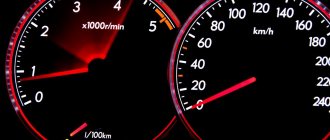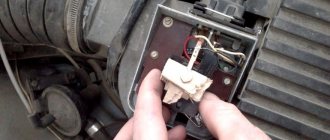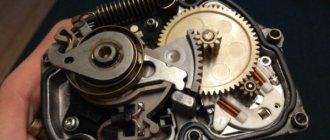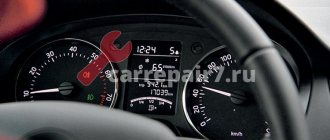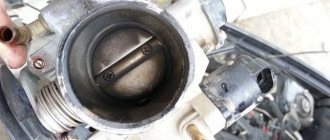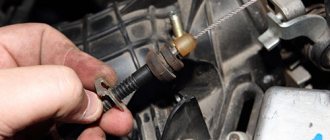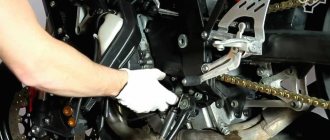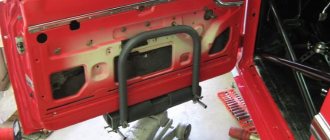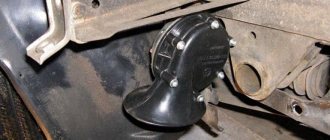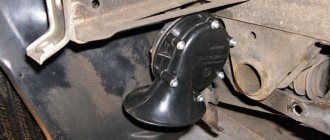The trend of recent years in the automotive industry is the gradual removal of the driver from the process of driving. Designers and marketers have not yet reached the point of losing the connection between arms and legs with turning wheels and braking, but everything is moving towards this. Not a single modern car is supplied to the market without an electronic throttle and an electronic accelerator.
Electronics are reliable things, but sometimes they fail.
The design and principle of operation of the electronic gas pedal
To understand how it works and functions, you need to roughly understand the general circuit of the mechanical analogue. The functions of these systems are similar, but the simplest unit can only be considered a traditional drive.
The gas pedal is a control element for the throttle and its damper. The function of the throttle is to regulate the amount of air. The more air, the higher the engine speed the crankshaft will rotate. The pedal is connected to the throttle drive via a cable drive or levers. All this significantly reduces the effort required to press the gas.
The operating principle of the electronic unit is more complex, but this makes the process of controlling speed easier. The electronic accelerator is used only on engines with an injection power system. Its device is completely electronic. It is based on electronic modules that convert electrical signals.
Noise when braking
High-frequency noise, squealing, and whistling can occur both during braking and, sometimes, during normal movement. The reason is the off-design mode of friction of the friction material on the working surface of the brake disc. Extreme wear on the brake pads and severe corrosion of the brake disc (often on the inside, “invisible” side) may be to blame. It happens that the brake pad lining has peeled off from the base. The list of possible causes continues with contamination of the pads, warping of the disc due to local overheating, improper fastening of the pads in the caliper, left pads or discs, etc.
Symptoms of a problem
Among the main signs of problems are:
- Absence of any reaction to the accelerator after starting the vehicle’s internal combustion engine;
- Dips, loss of throttle response while driving;
- Floating idle speed;
- Sharp jumps in speed when you gently press the accelerator;
- Idle speed too high.
The device contains movable electrical contacts, as well as conductive tracks - these elements are subject to wear during operation. In the operation of the engine, you can observe dips when picking up speed, unstable idling.
Related article: 5 of the best car speakers for high-quality sound
If there is a malfunction in the unit, the driver can see this by a warning light on the dashboard. In such a situation, the ECU will switch the engine to standby mode.
In this mode, you can observe a slow increase in speed, even if you press the accelerator sharply. In addition, the vehicle's fuel consumption may increase significantly.
If two sensors in a unit fail at once, the ECU will switch the operation of the internal combustion engine to emergency mode - the driver will not be able to influence the operation of the engine, the speed under any conditions will be slightly higher than the idle speed.
Checking the throttle assembly on Renault Megane 2
The throttle assembly is not dismountable and must be replaced in case of malfunction.
To work we need a multimeter.
Assignment of throttle body pins (data taken from Renault technical note (see after table))
| Pin number | Engine 1.4 | Engines 1.6 and 2.0 |
| 1 | Total weight" | Signal from the first track of the sensor |
| 2 | Signal from the first track of the sensor | Power + 5V sensor tracks |
| 3 | "-" electric motor | "+" of the electric motor |
| 4 | "+" of the electric motor | Signal from the second track of the sensor |
| 5 | Power + 5V sensor tracks | "-" electric motor |
| 6 | Signal from the second track of the sensor | Total weight" |
Excerpt from Renault technical note “Engine and its systems”, describing the contacts of the throttle valve connector. The left picture is for the 1.4 engine, the right is for the 1.6 and 2.0 engines.
We carry out the work in the following sequence:
- Remove the throttle assembly. How to do this, read in the article “Cleaning the throttle valve of Renault Megane 2”.
- Using a multimeter in ohmmeter mode, we measure the resistance of the sensor between pins 2 and 6 (for a 1.4 engine between pins 1 and 5, the serial numbers of the pins are marked on the insulator of the connector), which should be in the range of 750 - 1250 Ohms.
Location of terminals on the throttle assembly of engines 1.6 and 2.0.
- Similarly, we measure the resistance of the electric motor winding between terminals 3 and 4 (only for motor 1.4), which should be about 1.6 Ohms.
Note: Using this method you can only verify that the throttle assembly is faulty. A faulty throttle assembly must be replaced. A more detailed check can only be performed using special diagnostic equipment.
Adjustment
The adjustment process may vary on different car models, since different manufacturers use mechanisms of different designs. But the same principle can be applied for configuration. As for a specific model, it is better to find information on it in advance.
To begin the adjustment, the first step is to remove the pedal from the holding bracket. Next, loosen the screws securing the cover. One screw holds the cover in a certain position - it must be completely unscrewed. The cover is turned to the side clockwise until the end, then the screws are tightened again.
This is interesting: How to make a foam generator for a car wash with your own hands
This adjustment will reduce pedal response time. Some car owners note that after such adjustments, the response speed can even be compared with a mechanical pedal. Adjustment allows you to improve engine performance and improve the start of movement from a standstill.
In cases where a pedal with low sensitivity is needed, it is necessary to rotate the cover in the opposite direction - counterclockwise. The machine begins to respond to presses not so quickly.
Sometimes you can come across harmful adjustment tips - drivers advise placing shims under the lever. This is the wrong approach. Sometimes the pads get caught under the contact pads in the potentiometer, and the machine may lose control as a result.
The car pulls to the side
It is clear that not only the brakes can be to blame for a car drifting off course - the wheel alignment angles, the wheels themselves, and the steering can also be to blame. However, quite often questions arise specifically about the brakes, especially if the car pulls sideways when braking. Most often, jammed pistons in the cylinders of one of the circuits are to blame. It is possible that the wheel may brake due to the loosening of the bolts securing the pad guide to the steering knuckle, as well as the pads getting oily or getting brake fluid on them.
Perhaps an ice or salt crust has formed on the surface of the pads, or the pads are simply wet. Or one of the circuits of the brake system does not work - the pedal is low and the braking efficiency is low. Brake disc runout, wheel bearing wear, and brake drum out-of-roundness may also be to blame.
History of the approach
The business accelerator model was formed based on the experience gained by entrepreneurs and investors during the dot-com boom. Market practice at that time implied large investments in individual companies - and it was on this principle that startup incubators for information technology companies that existed in the late 1990s worked. The crisis of technology companies demonstrated the inadequacy of this model, and the financial losses of incubators earned them the sarcastic name “incinerators” (play on words: incubator and incinerator, lit. waste oven
).
With the renewed interest of venture capitalists in the Internet market, a model has emerged that takes into account the growth characteristics of startups from this industry. The pioneer among accelerators was Y Combinator, opened by Paul Graham, Trevor Blackwell, Robert Morris and Jessica Livingston in Boston in 2005. Instead of lengthy “incubation” of projects, Y Combinator offered three-month group training programs and small seed investments. The second Y Combinator intake took place in Silicon Valley. Following him, other well-known accelerators opened - Plug and Play and Techstars (English) Russian. The first European accelerator - London-based Seedcamp - began work in 2007, and by 2013 their number reached 50. A study of the startup support industry in Europe, conducted in 2014, demonstrated activity commensurate with the American startup ecosystem. According to various estimates, by 2014 there were from 300 to 400 accelerators operating in the world.
Among the first to use the Y Combinator model in Russia was the AddVenture accelerator, which opened in the technopark of Troitsk near Moscow in 2008. Two years later, the Bricolage accelerator, created by people from KupiVIP and its holding company Fast Lane Ventures, owned by the management company of the Bright Venture fund, opened by the founder of Price.ru Arkady Moreinis, Glavstart, Techdrive and Yandex.Factory, began recruiting for their programs. According to a joint study conducted by Firrma.ru and the Russian Venture Company in 2013, Fastlane Ventures, like Farminers, which opened a year later, remained among the most active Russian accelerators. In addition to them, the list includes the Internet Initiatives Development Fund, GenerationS, Pulsar Ventures, API Moscow, Global TechInnovations, iDealMachine, MetaBeta.
Model features
The US Department of Commerce has designated business accelerators
as incubator support institutes and incubation programs for investment-ready companies. The main focus of accelerators is technology, in particular software startups: the cost of launching and developing these companies has decreased significantly. The role of accelerators in venture financing is to select promising startups for funds and prepare teams to attract investment rounds.
In the absence of a generally accepted definition, the characteristic features of business accelerators allow us to draw a line between them and traditional incubators. Summarizing thesis from Jed Christensen's MBA thesis, "Copying Y Combinator"
(2009), research from The Startup Factories
authored by Paul Miller and Kirsten Bound (2011) and published by Susan Cohen in the journal
Innovations: Technology, Governance, Globalization
of the Massachusetts Institute of Technology (December 2013), key features of the model can be noted.
- The composition of accelerators is formed on a competitive basis. Teams go through a rigorous selection process, interviews, and interviews. The number of applications to well-known accelerators (such as Y Combinator) reaches thousands, but only a few dozen teams are accepted into one set.
- Qualifying teams are trained simultaneously as part of a stream (also called a roster, set, or cohort). Constant communication promotes the exchange of experiences and mutual support.
- Most accelerators provide seed funding to residents and receive income from the growth in the value of their shares in the capital of invested startups.
- Acceleration programs are limited to several months, during which teams undergo training in areas close to entrepreneurship, communicate with well-known entrepreneurs, investors and niche specialists, and work with mentors. The development of a business model plays a major role in the learning process. Upon completion of acceleration, teams present their projects to investors and have the opportunity to attract the next round of funding.
Priora - why the speed fluctuates
If the speed on a Priora with E-gas fluctuates, or the warm-up speed disappears, this means that the sensors are not working correctly, “the contact is coming off”. The sensor does not constantly send signals to the electronic control unit, and therefore the ECU acts proactively - it sends commands to the gearbox to close/open the damper. Any diagnostics will show a malfunction of one of the sensors, and first it’s worth looking at its contacts to see if they have become acidic, if the wires are coming off, etc. And if the situation with them is irreparable, you will have to change the sensor.
Renault Laguna 2008, engine Gasoline 2.0 liter., 140 hp, Front drive, Manual — electronics
Comments 20
Hello everyone, the other day I changed the lambda at a service station, asked me to clean the throttle valve at the same time, after the procedures were carried out - I left and did not pay attention to the moment with idling, in the parking lot (I have an automatic), the revolutions fluctuate 1400-1800 and when downshifting From the second to the first, the transition began to go with some kind of jerk, again, it felt like it was due to an increased speed or an incorrect position of the damper. I went to an electrician for a clip for adaptation (or whatever it’s called) of the throttle, he set it to the default on my engine - 750 rpm, but in fact they did not drop to this value
That is, they are programmed, but do not go down. With what it can be connected? Did you put the throttle back in place crookedly? Do you need to physically tighten something? And here’s another thing: when you stand in the parking lot and turn the steering wheel, the speed drops from these very 1400-1800 to 1200. How is this even possible?
Try doing manual adaptation and see
Manual - is it the one described in this topic? “Apply supply voltage” + “after the ignition switch” how do you mean this? Thank you
Yes, you need to insert a card
Did not work. I’ll go to the service center where they cleaned it, show the video, and let them tinker.
Good luck, write later what happened
The fact is that the throttle valve of the F4P engine does not have a similar coating, which was mentioned in the video above; the valve itself, when closed, has no gaps, so it could not siphon from there.
Everything turned out to be much simpler!
Along with cleaning, it was necessary to pay attention to the condition of the O-rings. The small ring that goes into the engine turned out to be in a deplorable state; when I tried to remove it, it simply burst, because
Over time, it simply became stale and lost its sealing properties and let air in from there.
We replaced the ring, cleaned, just in case, all the contacts, tightened the terminals, put them back in place and voila - the rpm is 750-800, as it should be, they float a little, but within the “normal” limits I still have suspicions that what something is wrong with the power steering, because... When you turn the steering wheel while the car is parked, the speed decreases.
Oh yes, all this work, this time, was carried out with the battery terminal removed, so as not to go back to the electrician for a clip to initialize the throttle.
P.S.: the car began to pick up/reduce speed perfectly, change gears (let me remind you that I have an automatic transmission) without any hesitation, no push, no kick, everything is just perfect.
Source
Repair
If there are any problems with the pedal, then only a complete replacement of the unit will help. But before changing anything, it is worth identifying the cause of the malfunction. To do this, you can use a multimeter test.
You can disconnect the sensors and the block and remove the pedal. Check the resistance - when you press the gas it should change slowly. Jumps in indicators indicate malfunctions.
But sometimes repairs are possible - for example, the wiring is damaged. If a wiring defect is detected, you can use the following diagram.
- Release the axis on which the gear is attached.
- Remove the wiring harness.
- Then the wires are soldered off.
- Release the bracket and pull out the cable.
Next, change the wires and solder them according to the connector under the pedal.
Source
The value of acceleration
Jed Christensen's research noted that when choosing accelerator programs, startup founders focus on long-term interests and the benefits that participation can bring. Their priority is building relationships with future investors and the reputation of the program, which contributes to additional attention from journalists and users.
Seed funding
Although the amount of seed funding provided by the accelerator is rarely a determining factor, it is important because it allows the team to focus on the project. It also covers the startup’s basic expenses for moving the team to the city where the program is being held and hiring outside specialists to develop the product.
Reputation
Well-known accelerators that have produced multimillion-dollar startups (for example, Reddit, Airbnb, Dropbox, Stripe in the case of Y Combinator) attract special interest from journalists and investors. Participation in such a program helps residents build their own reputation, facilitates communication with the media and attracting early followers (English)Russian..
Feedback
Participation in the accelerator allows a startup to receive expert assessment from experienced entrepreneurs and investors (whether they are the founders of the accelerator, presenters of lectures and seminars, and other guests), invited specialists and other teams.
Training and mentoring
As part of their training, residents receive knowledge in the fields of law, finance, marketing and sales organization, learn to negotiate, and receive assistance in technical development. Accelerators train residents in the best market practices for business development (for example, lean development, which helps to avoid mistakes in company development.
Reaching investors
Accelerators select promising projects and talented entrepreneurs, and thereby attract investors and business angels
At meetings and events and during the “Demo Day” that concludes the acceleration program, residents present projects and can attract the attention of investment funds or receive recommendations and valuable contacts among venture capitalists
Methods for diagnosing ECUs and errors
Let's consider options for carrying out service operations on Megans:
Starting from the second generation Megan, the ECU provides for the display of service messages on the instrument panel display. How to activate the mode:
- Insert the chip card into the ignition socket.
- Press the ADAC key. It is located in the area of the right lever under the steering wheel.
- Simultaneously hold down the engine start button for 2 seconds.
- The instrument needles will begin to move intermittently. Service mode has started.
The error code is determined by the number of flashes of the immobilizer light in the central part of the dashboard. The number of times the indicator turns on is a four-digit message. A code of four zeros means no faults
Deeper service – using external scanner systems. The device is connected via the OBD2 diagnostic socket on the car console. After connection, the device interrogates the vehicle components through the ECU. At the same time, the ROM of the control unit is read. Error codes are recorded and the scanner automatically determines their meaning.
The devices allow:
- check all machine components;
- count, decipher codes;
- analyze the operation of nodes in real time;
- test electronic modules that support this function.
The CAN bus is used to exchange information.
Reviews of OBD2 diagnostic car scanners
This section provides descriptions of diagnostic scanners and adapters. Before purchasing a scanner for your car, it is recommended that you read reviews of the most popular equipment models.
The firmware of the electronic control unit is performed by programmers. Example - Galletto 4 revision 54. For the procedure you need:
- laptop;
- new firmware (serial, chip);
- a program for downloading software into the block’s memory.
Important: a large number of owners are faced with the problem of turning off the power when updating new firmware. This will result in an incomplete update and the car will not work
To avoid sudden shutdown of the electronics, it is recommended to hold down the “Start” button for 10 seconds.
During the Renault software update procedure, the engine cooling fan turns on. This is a firmware feature. To avoid damaging the battery, we recommend removing the terminal from the fan.
Frequently asked questions about auto diagnostics via a computer or smartphone:
Let's look at popular questions about the Renault Megane 2 service.
Suitable adapters, cables and programs for service
| Control unit brand | Data bus | Scanner | BY |
| ECU Siemens EMS 3120, 3125, 3130, 3132 | CAN |
|
|
| Bosch | |||
| DELPHI |
* For scanners based on ELM 327, chip revision 1.5 is recommended, for example Scan Tool Pro
Important:
Renault has implemented a unified scheme for communicating modules via the CAN bus. Polling by external equipment occurs in the same way
For ELM327 it is important to choose the right modification. Stable operation, reading the ECU memory is ensured by version 1.5
DELPHI control units are diagnosed using a scanner of the same name. There are often analogues of the DS series on the market at low cost. In practice, there are frequent cases of scanner failure due to poor quality.
Suitable scanners for Renault Megane
The following equipment is used for Renault Megane II:
- RENAULT CAN CLIP. Dealer scanner suitable for the entire range of Renault cars. Has its own software.
- Launch CReader VI S. Portable device equipped with a built-in display. The device supports deep diagnostics of the machine, reading the memory of the control unit.
- Launch CReader 7S – updated version. Used in the Renault line to reset service ranges. Communicates well with blocks such as BOSCH and Siemens.
- Black CDP+. Analogue of the famous AUT OM CDP. Professional scanner for multi-brand use. Suitable for Renault Megane second generation.
A powerful option for comprehensive vehicle analysis is Renault CAN CLIP. Designed to work with cars of this brand.
Features of professional diagnostics without a dealer CLIP device
Renault Megane diagnostics, depending on the device and software, can be divided into three types:
- connection via an Android-compatible device using Torque PRO and extended PID + OBDII ELM327 adapter version 1.5;
- diagnostics via a computer or Android-compatible device, using PyREN scripts +OBDII ELM327 adapter version 1.5;
- use of diagnostic software DDT2000 + OBDII ELM327 adapter version 1.5.
You can work with DDT2000 databases either through PyRen itself on a PC or through another shell called DDT4ALL.
Procedure:
- Installing Torque Pro on an Android device.
- Move the .csv configuration file to the path /.torque/extendedpids. It has an extended set of PID instructions. This will allow the scanner to “communicate” with most vehicle modules. A convenient way to transfer configuration files is Total Commander.
- For Megane 2 you need to change the standard initialization string. Working version: atat0\natstff\natat1\natal\natcra7e8\natfcsh7e0\natfcsd300000\natfcsm1\nattp6\n10C0
After making the preliminary settings, you can connect to the unit. The circuit was tested on ICE control units K9K 832, 836, 837 – Siemens, Valeo.
Torque Pro allows you to diagnose most vehicle systems, analyze sensor data in real time, and conduct tests of electronic modules.
Note:
Recently, for RENAULT cars, it has become possible to carry out professional in-depth diagnostics on the knee without the use of an expensive dealer device called CLIP.
For example, knowing the necessary scenarios, you can reprogram the parameters of any car unit, or change the factory calibration of the fuel tank, activate the on-board computer, the outside temperature sensor. All you need is an Android smartphone, PyRen software and the correct Bluetooth OBDII adapter ELM327.
Source
